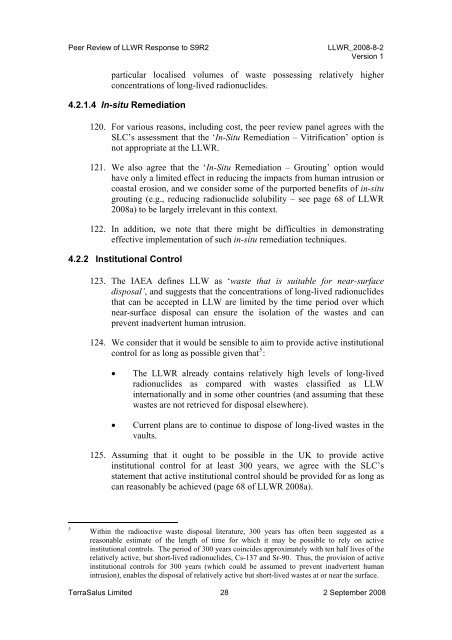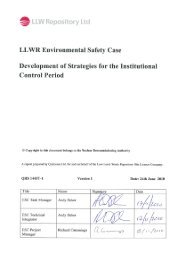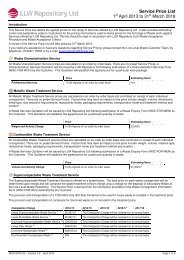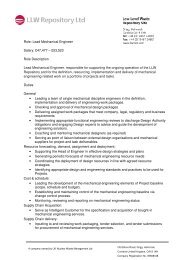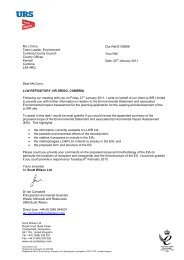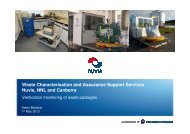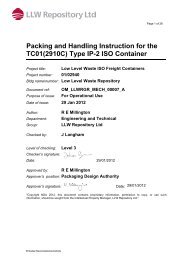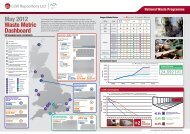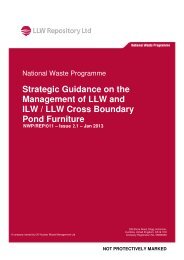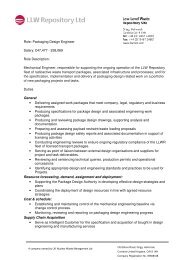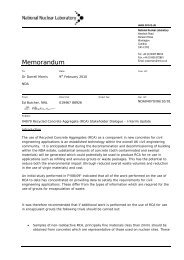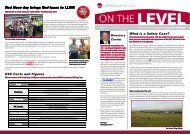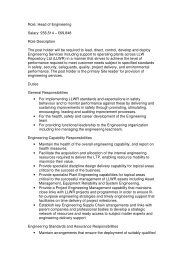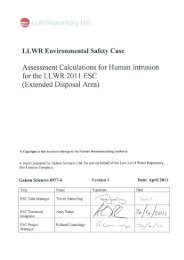Independent Peer Review of - Low Level Waste Repository Ltd
Independent Peer Review of - Low Level Waste Repository Ltd
Independent Peer Review of - Low Level Waste Repository Ltd
Create successful ePaper yourself
Turn your PDF publications into a flip-book with our unique Google optimized e-Paper software.
<strong>Peer</strong> <strong>Review</strong> <strong>of</strong> LLWR Response to S9R2LLWR_2008-8-2Version 1particular localised volumes <strong>of</strong> waste possessing relatively higherconcentrations <strong>of</strong> long-lived radionuclides.4.2.1.4 In-situ Remediation120. For various reasons, including cost, the peer review panel agrees with theSLC’s assessment that the ‘In-Situ Remediation – Vitrification’ option isnot appropriate at the LLWR.121. We also agree that the ‘In-Situ Remediation – Grouting’ option wouldhave only a limited effect in reducing the impacts from human intrusion orcoastal erosion, and we consider some <strong>of</strong> the purported benefits <strong>of</strong> in-situgrouting (e.g., reducing radionuclide solubility – see page 68 <strong>of</strong> LLWR2008a) to be largely irrelevant in this context.122. In addition, we note that there might be difficulties in demonstratingeffective implementation <strong>of</strong> such in-situ remediation techniques.4.2.2 Institutional Control123. The IAEA defines LLW as ‘waste that is suitable for near-surfacedisposal’, and suggests that the concentrations <strong>of</strong> long-lived radionuclidesthat can be accepted in LLW are limited by the time period over whichnear-surface disposal can ensure the isolation <strong>of</strong> the wastes and canprevent inadvertent human intrusion.124. We consider that it would be sensible to aim to provide active institutionalcontrol for as long as possible given that 5 :The LLWR already contains relatively high levels <strong>of</strong> long-livedradionuclides as compared with wastes classified as LLWinternationally and in some other countries (and assuming that thesewastes are not retrieved for disposal elsewhere).Current plans are to continue to dispose <strong>of</strong> long-lived wastes in thevaults.125. Assuming that it ought to be possible in the UK to provide activeinstitutional control for at least 300 years, we agree with the SLC’sstatement that active institutional control should be provided for as long ascan reasonably be achieved (page 68 <strong>of</strong> LLWR 2008a).5Within the radioactive waste disposal literature, 300 years has <strong>of</strong>ten been suggested as areasonable estimate <strong>of</strong> the length <strong>of</strong> time for which it may be possible to rely on activeinstitutional controls. The period <strong>of</strong> 300 years coincides approximately with ten half lives <strong>of</strong> therelatively active, but short-lived radionuclides, Cs-137 and Sr-90. Thus, the provision <strong>of</strong> activeinstitutional controls for 300 years (which could be assumed to prevent inadvertent humanintrusion), enables the disposal <strong>of</strong> relatively active but short-lived wastes at or near the surface.TerraSalus Limited 28 2 September 2008


